Electronic Discovery
eDiscovery Business Confidence Takes a Major Spring Forward: eDiscovery Trends
Get it? The Complex Discovery eDiscovery Business Confidence Survey is into its third year and the results are in for the Spring 2018 eDiscovery Business Confidence Survey! As was the case for the 2016 Winter, Spring, Summer and Fall surveys, the 2017 Winter, Spring, Summer and Fall surveys and the 2018 Winter survey, the results for the Spring survey are published on Rob Robinson’s terrific Complex Discovery site. How confident are individuals working in the eDiscovery ecosystem in the business of eDiscovery? Let’s see.
As always, Rob provides a complete breakdown of the latest survey results, which you can check out here. As I’ve done for the past few surveys, I will provide some analysis and, this year, I’ll take a look at all surveys conducted to look at trends over time. So, this time, I will look at the results for all ten surveys.
The Spring 2018 Survey response period was initiated in March, and continued until registration of exactly 100 responses by last week. Rob notes that this limiting of responders to 100 (or so) individuals is designed to create linearity in the number of responses for each quarterly survey. So, in the future, if you want your voice heard, respond early!
This Survey is Consultant Heavy: For the first time ever, those who identified themselves as Consultants lead the way. Of the types of respondents, 33% were Consultants, followed by Software and/or Services Provider (30%) and Law Firm (29%). As always, if you count law firms as providers (they’re technically both providers and consumers), this is a very provider heavy survey (which makes perfect sense as they would be most interested in eDiscovery business confidence). Here’s a graphical representation of the trend over the ten surveys to date:

This is the most provider heavy survey yet at 92% of total respondents! So, how confident are providers in eDiscovery business confidence? See below.
More Than Two Thirds of Respondents Consider Business to Be Good: Yowza! Over two third (68%, to be exact) of respondents rated the current general business conditions for eDiscovery in their segment to be good, with 7% rating business conditions as bad. That’s a record percentage of “good” votes. Last quarter, those numbers were 58% and 7% respectively. Will the positive sentiment continue? We’ll see. Here is the trend over the ten surveys to date:
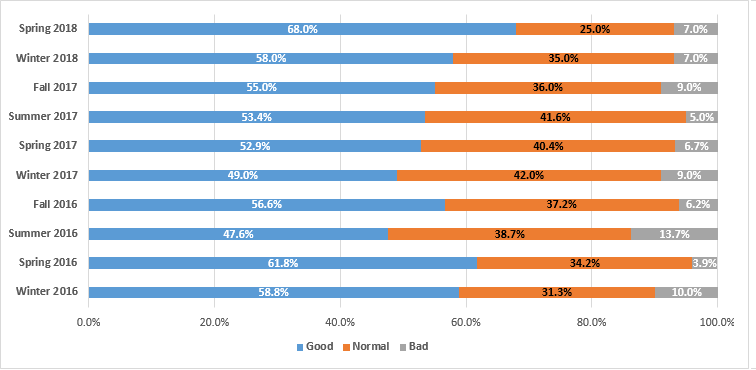
This survey shows the highest percentage of “business is good” respondents ever by 6.2%! Spring 2016 was the previous high. But, do respondents expect that to continue? See below.
Revenue and Profit Expectations Six Months From Now Are Strong: Almost all respondents (94%) expect business conditions will be in their segment to be the same or better six months from now (one tick lower than last quarter’s 95%), and the percentage expecting business to be better fell six points to 50%. Revenue (at combined 96% for the same or better) is three points higher than the last quarter. Profit expectations (combined 86%) also rose three points from last quarter, with those expecting higher profits at an all-time high of 53%! Here is the profits trend over the ten surveys to date:
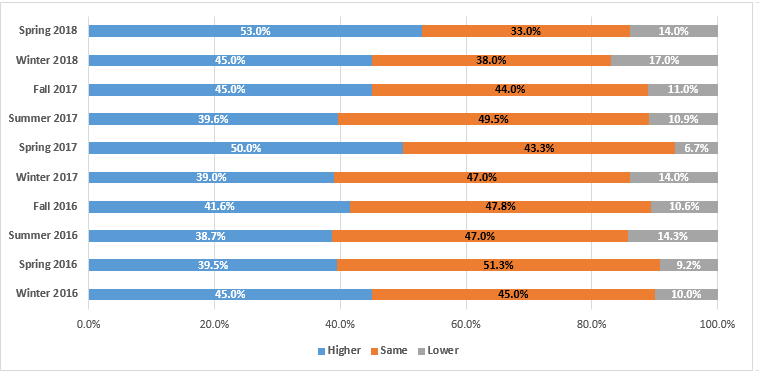
Perhaps the weirdest results this time as both revenue and profits scored higher than general business conditions did. Go figure.
It’s Budgetary Constraints’ Turn to Be Most Impactful to eDiscovery Business: Budgetary Constraints was the top impactful factor to the business of eDiscovery over the next six months at 22%, with Increasing Volumes of Data next up at 21%. Data Security was close behind in third at 19% and Increasing Types of Data (16%) was fourth. Inadequate Technology and Lack of Personnel brought up the rear at 11% each. The graph below illustrates the distribution over the ten surveys to date:
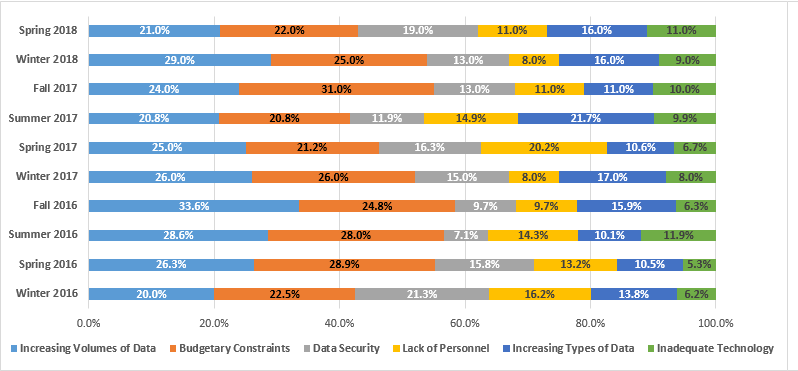
Once again, Budgetary Constraints and Increasing Volumes of Data are the top two, but for the first time, all six factors were over 10%. That’s a fairly even distribution.
Even Distribution Between Management and “Rank and File”: For the first time since Summer 2016, the Executive Leadership respondents (35%), Operational Management (34%) and Tactical Execution respondents (31%) were virtually even. So, this survey reflects even input from execs, managers and “doers”. Here’s the breakdown over the ten surveys to date:
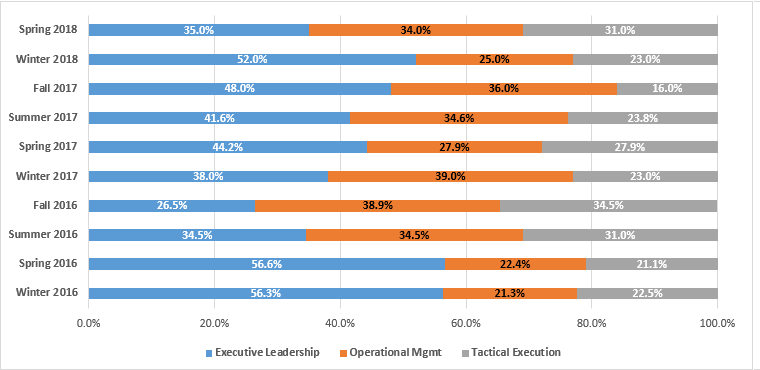
Clearly, the variance in distribution shows that the respondents for this survey vary from quarter to quarter, so it’s not the same people giving the same answers each time.
Again, Rob has published the results on his site here, which shows responses to additional questions not referenced here. Check them out.
So, what do you think? What’s your state of confidence in the business of eDiscovery? Please share any comments you might have or if you’d like to know more about a particular topic.

Sponsor: This blog is sponsored by CloudNine, which is a data and legal discovery technology company with proven expertise in simplifying and automating the discovery of data for audits, investigations, and litigation. Used by legal and business customers worldwide including more than 50 of the top 250 Am Law firms and many of the world’s leading corporations, CloudNine’s eDiscovery automation software and services help customers gain insight and intelligence on electronic data.
Disclaimer: The views represented herein are exclusively the views of the author, and do not necessarily represent the views held by CloudNine. eDiscovery Daily is made available by CloudNine solely for educational purposes to provide general information about general eDiscovery principles and not to provide specific legal advice applicable to any particular circumstance. eDiscovery Daily should not be used as a substitute for competent legal advice from a lawyer you have retained and who has agreed to represent you.
Judge Recommends Jury Decision on Impact of Spoliation of Emails: eDiscovery Case Law
In BankDirect Capital Fin., LLC v. Capital Premium Fin., Inc., No. 15 C 10340 (N.D. Ill. April 4, 2018), Illinois Magistrate Judge Jeffrey Cole recommended that the court follow the decision in Cahill v. Dart and “allow the appropriate evidence to be presented to the jury” to enable it to determine the “impact, if any, the non-production of the challenged emails has on the merits of the parties’ claims”. If the court was not inclined to let the matter go to the jury, Judge Cole recommended that the court give a permissive spoliation instruction to the jury informing them of the destruction of the requested emails and that they could consider the deletion of the emails to be evidence in considering claims and counter-claims of the parties.
Case Background
In this case regarding breach of a marketing collaboration agreement between the parties and a counter-claim against the owner of the plaintiff, alleging the marketing agreement was negotiated in bad faith, the defendant raised concerns that the plaintiff had produced no emails from Fall 2010 through November 2011 (the period in which the parties were negotiating their Agreement). The plaintiff indicated that it changed servers in November 2011 and no longer had possession of any emails prior to then. In response to the suggestion that the loss of the pre-November 2011 emails might have been deliberate, the plaintiff claimed that the server change was “years before any party could have foreseen litigation”. Though the parties agreed to a declaration by an employee of the plaintiff regarding this, the plaintiff never provided one.
In May 2017, the defendant served a notice for the deposition of a corporate representative of the plaintiff to cover a number of topics related to the missing emails, but the parties continued to dispute the production of a plaintiff witness before finally agreeing to depose an employee of the bank owner company of the plaintiff. He testified that the new email archive system was not fully installed at the plaintiff’s organization until July 2012, that five years of emails were kept at the time and that emails were kept until automatically deleted once they aged five years. This meant that emails going back to November 2010 were in existence and obtainable as of November 2015 when the Complaint was filed, not purged when the plaintiff changed servers.
In addition, the President and CEO of the plaintiff admitted he maintained a separate electronic or computerized “folder” for emails regarding the agreement, this folder would have contained all the communications related to it as of July 2012 when the migration to the new archive was complete and he knew of no reason why he would have deleted them. Acknowledging that he was “personally responsible for putting in place a litigation hold”, he also admitted that neither he nor anyone else at the plaintiff or its owner company ordered the suspension of the automatic deletion of archived emails until at least October of 2016, nearly a year after the defendant filed suit, noting that he didn’t think there were any bad emails, so their deletion wasn’t problematic. The chain of events led to the defendant filing a Motion for Spoliation Sanctions seeking the entry of a default judgment or, alternatively, an adverse inference sanction against the plaintiff.
Judge’s Ruling
In providing his recommendation, Judge Cole stated that the plaintiff CEO testimony “is simply not credible”. Continuing, he said, “No reasonable, successful businessman would be so naive as to think that prior, positive exchanges of emails with one’s present accuser had no capacity to help prove that Capital’s charges were baseless and pretextual.”
Summing up his observations, Judge Cole stated that “there can be no serious doubt that the now unavailable emails ought to have been preserved, and that BankDirect, despite its admitted knowledge that documents were not to be destroyed, intentionally chose not to take reasonable (and quite easy) steps to preserve them.” As a result, Judge Cole offered the following recommendation:
“Accordingly, it is recommended that the court follow Cahill and, as a matter of its inherent discretion, allow the appropriate evidence to be presented to the jury, which, under proper instructions, will determine the reasons for the non-production and the impact, if any, the non-production of the challenged emails has on the merits of the parties’ claims. Alternatively, if the court is not inclined to let the matter go to the jury, it is recommended that the court give a permissive spoliation instruction to the jury informing them of the destruction of the requested emails and that they could consider the deletion “of the emails to be evidence (not conclusive of course)” in considering BankDirect’s claim and Capital’s counterclaim.”
So, what do you think? Should the judge have recommended a default judgment sanction in this case? Please share any comments you might have or if you’d like to know more about a particular topic.

Case opinion link courtesy of eDiscovery Assistant.
Sponsor: This blog is sponsored by CloudNine, which is a data and legal discovery technology company with proven expertise in simplifying and automating the discovery of data for audits, investigations, and litigation. Used by legal and business customers worldwide including more than 50 of the top 250 Am Law firms and many of the world’s leading corporations, CloudNine’s eDiscovery automation software and services help customers gain insight and intelligence on electronic data.
Disclaimer: The views represented herein are exclusively the views of the author, and do not necessarily represent the views held by CloudNine. eDiscovery Daily is made available by CloudNine solely for educational purposes to provide general information about general eDiscovery principles and not to provide specific legal advice applicable to any particular circumstance. eDiscovery Daily should not be used as a substitute for competent legal advice from a lawyer you have retained and who has agreed to represent you.
Here’s the Latest Buyers Guide for Everything “eDisclosure”: eDiscovery Trends
How many suppliers of eDiscovery (“eDisclosure”) software and services are there? At least 98. How do I know that? I know that because that’s how many suppliers Andrew Haslam lists in the eDisclosure Systems Buyers Guide – 2018 Edition.
Authored once again by litigation support and “eDisclosure” (that’s what they call eDiscovery across the pond) expert Andrew Haslam, the sixth edition of the eDisclosure Systems Buyers Guide provides an overview of key technology considerations, industry approaches and vendor capabilities regarding eDisclosure. Covering topics from the EDRM Model to vendor service and software analysis, the guide provides a complete and credible resource for legal and IT professionals seeking to understand and apply eDisclosure concepts, processes, techniques, and tools.
The target audience for the Guide are those individuals who understand they have a requirement, but don’t know how to proceed with the next steps. It is assumed that people within organizations that have a litigation support function, will turn to them in the first instance for advice, but might use this document as a primer on what’s available.
The Guide is based on Andrew Haslam’s general experience in the marketplace, also drawing from a number of vendor procurement exercises. The information on firms and software tools has been provided by the organizations themselves, with moderation from the author. Throughout the guide, Andrew sprinkles boxes that are notes, best practice recommendations and warnings (which are designated by a bomb with a lit fuse icon) to help provide guidance to readers for best practices.
While the Guide is a very large 435 page PDF guide, it’s still easy to navigate, with a detailed (and linked) table of contents that provides an Executive Summary, Guide Structure, a breakdown of each of the EDRM phases, a section on cooperation in England and Wales, technology areas, a market survey, a proposed procurement approach in selecting vendors, additional resources and that comprehensive list of service “suppliers” and software providers (98 suppliers, 73 software providers) which comprises the majority of the guide. If you provide both services and software, you’re listed in both sections. So, for example, CloudNine (shameless plug warning!) is listed on both page 96 of the document in the suppliers section and page 250 of the document in the software section.
When it comes to coverage of the providers, the Guide is more than just a cursory listing, it’s a detailed listing that includes a detailed description of their services, providing the buyer with a terrific head start in understanding what each company does and whether their services and/or software might meet their needs.
Andrew is currently employed as the UK eDisclosure Project Manager for Squire Patton Boggs, so, once again, he makes sure to note that all opinions within the Guide are Andrew’s personal viewpoints and they do not represent any views, opinions or strategies of Squire Patton Boggs. You can get access a copy via Legal IT Insider here.
So, what do you think? Are you in the market for an eDiscovery (eDisclosure) provider or solution? Please share any comments you might have or if you’d like to know more about a particular topic.

Sponsor: This blog is sponsored by CloudNine, which is a data and legal discovery technology company with proven expertise in simplifying and automating the discovery of data for audits, investigations, and litigation. Used by legal and business customers worldwide including more than 50 of the top 250 Am Law firms and many of the world’s leading corporations, CloudNine’s eDiscovery automation software and services help customers gain insight and intelligence on electronic data.
Disclaimer: The views represented herein are exclusively the views of the author, and do not necessarily represent the views held by CloudNine. eDiscovery Daily is made available by CloudNine solely for educational purposes to provide general information about general eDiscovery principles and not to provide specific legal advice applicable to any particular circumstance. eDiscovery Daily should not be used as a substitute for competent legal advice from a lawyer you have retained and who has agreed to represent you.
Why Is TAR Like a Bag of M&M’s?, Part Four: eDiscovery Best Practices
Editor’s Note: Tom O’Connor is a nationally known consultant, speaker, and writer in the field of computerized litigation support systems. He has also been a great addition to our webinar program, participating with me on several recent webinars. Tom has also written several terrific informational overview series for CloudNine, including eDiscovery and the GDPR: Ready or Not, Here it Comes (which we covered as a webcast), Understanding eDiscovery in Criminal Cases (which we also covered as a webcast) and ALSP – Not Just Your Daddy’s LPO. Now, Tom has written another terrific overview regarding Technology Assisted Review titled Why Is TAR Like a Bag of M&M’s? that we’re happy to share on the eDiscovery Daily blog. Enjoy! – Doug
Tom’s overview is split into four parts, so we’ll cover each part separately. The first part was covered last Tuesday, the second part was covered last Thursday and the third part was covered this past Tuesday. Here’s the final part, part four.
Justification for Using TAR
So where does this leave us? The idea behind TAR – that technology can help improve the eDiscovery process – is a valuable goal. But figuring out what pieces of technology to apply at what point in the workflow is not so easy, especially when the experts disagree as to the best methodology.
Is there a standard, either statutory or in case law to help us with this determination? Unfortunately, no. As Judge Peck noted on page 5 of the Hyles case mentioned above, “…the standard is not perfection, or using the “best” tool, but whether the search results are reasonable and proportional.”
FRCP 1 is even more specific.
These rules govern the procedure in all civil actions and proceedings in the United States district courts, except as stated in Rule 81. They should be construed, administered, and employed by the court and the parties to secure the just, speedy, and inexpensive determination of every action and proceeding. (emphasis added)
The Court in any given matter decides if the process being used is just. And although we have seen ample evidence that computers are faster than humans, speed may not always equate to accuracy. I’ll leave aside the issue of accuracy for another day since two of the most interesting case studies, the EDI/Oracle study and the most recent Lex Geek “study” in which a human SME scored exactly the same number of accurate retrievals as the computer system.
I am most interested in pointing out that few if any studies or case law opinions address the issue of inexpensive. To his credit, Judge Peck did note in footnote 2 on page 3 of the Hyles opinion that “…some vendor pricing models charge more for TAR than for keywords.” but went on to note that typically those costs are offset by review time savings. With all due respect to Judge Peck, to whose opinion I give great credence, I am not sure that is necessarily the case.
Most case studies I have seen emphasize speed or accuracy and don’t even mention cost. Yet the increased emphasis on proportionality in eDiscovery matters makes this third requirement more important than ever. Maura Grossman does provide for this concern in her Broiler Chicken protocol but only to the extent that a concerned party should bring any issues to the Special Master.
The proportionality issue is an important one. Principle 4 of the Sedona Conference Commentary on Proportionality in Electronic Discovery states that “The application of proportionality should be based on information rather than speculation.” Absent specific statistics regarding TAR costs, it seems we are all too often engaging in speculation about the true cost a specific technology.
I am mindful of the decision in the case of In Re State Farm Lloyds in March of 2017 (covered by eDiscovery Daily here), in which the Texas Supreme Court, deciding a matter involving the form of production and noting it’s parity with the Federal Rules, remarked that one party made an assertion of an “… extraordinary and burdensome undertaking … without quantifying the time or expense involved.” Meaningful case studies and their statistics about the actual costs of various technologies would go a long way towards resolving these sort of disputes and fulfilling the requirement of FRCP 1.
Conclusions
Although the use of TAR has been accepted in the courts for several years, there is still a great deal of confusion as to what TAR actually is. As a result, many lawyers don’t use TAR at all.
In addition, the lack of definitions makes pricing problematic. This means that the several of the Federal Rules of Civil Procedure are difficult if not impossible to implement including FRCP 1 and FRCP 26(b)(1).
It is essential for the proper use of technology to define what TAR means and to determine not only the different forms of TAR but the costs of using each of them. Court approval of technology such as predictive coding, clustering and even AI all depend on clear concise information and cost analysis. Only then will technology usage be effective as well as just, speedy and inexpensive.
So, what do you think? How would you define TAR? As always, please share any comments you might have or if you’d like to know more about a particular topic.
Image Copyright © Mars, Incorporated and its Affiliates.

Sponsor: This blog is sponsored by CloudNine, which is a data and legal discovery technology company with proven expertise in simplifying and automating the discovery of data for audits, investigations, and litigation. Used by legal and business customers worldwide including more than 50 of the top 250 Am Law firms and many of the world’s leading corporations, CloudNine’s eDiscovery automation software and services help customers gain insight and intelligence on electronic data.
Disclaimer: The views represented herein are exclusively the views of the author, and do not necessarily represent the views held by CloudNine. eDiscovery Daily is made available by CloudNine solely for educational purposes to provide general information about general eDiscovery principles and not to provide specific legal advice applicable to any particular circumstance. eDiscovery Daily should not be used as a substitute for competent legal advice from a lawyer you have retained and who has agreed to represent you.
CLOUD Act Renders Supreme Court Decision in the Microsoft Case Moot: eDiscovery News
The Supreme Court heard arguments on February 27th over Microsoft’s ongoing data privacy case involving email stored in Microsoft datacenter in Ireland. Supposedly, according to reports from those attending, the justices didn’t seem swayed by Microsoft’s claims that data stored overseas should not be accessible to government prosecutors. However, Congress has since passed the CLOUD (Clarifying Lawful Overseas Use of Data) Act. Parties on all sides of the case expected the passage of the CLOUD Act to render the Microsoft case moot. And, they were right.
Yesterday, in an unsigned three-page opinion, the Supreme Court justices threw out a ruling by the U.S. Court of Appeals for the 2nd Circuit, explaining that the case had become moot.
On March 23, Congress passed – and President Donald Trump signed – legislation that directly addressed the legal issue before the court in the Microsoft case. The CLOUD Act contains a provision that requires email service providers to disclose emails within their “possession, custody, or control,” even when those emails are located outside the United States. Once the CLOUD Act was in effect, the federal government went back to court and got a new warrant, which has replaced the warrant originally served on Microsoft back in 2013. According to ZDNet, Microsoft officials said they are reviewing the new DOJ warrant before deciding how to proceed.
Microsoft officials repeatedly have said they were in favor of legislation, not legal action, in settling these kinds of matters. Though it seems contradictory, Microsoft actually backed The CLOUD Act, which stipulates that cloud providers comply with court orders for data regardless of whether the information is located in the U.S. or not.
Microsoft released the following statement from its President and Chief Legal Officer Brad Smith yesterday regarding the Supreme Court’s move:
“We welcome the Supreme Court’s ruling ending our case in light of the CLOUD Act being signed into to law. Our goal has always been a new law and international agreements with strong privacy protections that govern how law enforcement gathers digital evidence across borders. As the governments of the UK and Australia have recognized, the CLOUD Act encourages these types of agreements, and we urge the US government to move quickly to negotiate them.”
In light of all these facts, the court concluded, there is no longer a “live dispute” between the United States and Microsoft on the legal question that the justices had agreed to review. The court therefore invalidated the 2nd Circuit’s ruling and sent the case back to the court of appeals with instructions to vacate the district court’s rulings against Microsoft and to direct the district court to dismiss the case.
So, what do you think? Does the CLOUD Act end the disputes over data stored by internet providers overseas? Please share any comments you might have or if you’d like to know more about a particular topic.

Sponsor: This blog is sponsored by CloudNine, which is a data and legal discovery technology company with proven expertise in simplifying and automating the discovery of data for audits, investigations, and litigation. Used by legal and business customers worldwide including more than 50 of the top 250 Am Law firms and many of the world’s leading corporations, CloudNine’s eDiscovery automation software and services help customers gain insight and intelligence on electronic data.
Disclaimer: The views represented herein are exclusively the views of the author, and do not necessarily represent the views held by CloudNine. eDiscovery Daily is made available by CloudNine solely for educational purposes to provide general information about general eDiscovery principles and not to provide specific legal advice applicable to any particular circumstance. eDiscovery Daily should not be used as a substitute for competent legal advice from a lawyer you have retained and who has agreed to represent you.
Why Is TAR Like a Bag of M&M’s?, Part Three: eDiscovery Best Practices
Editor’s Note: Tom O’Connor is a nationally known consultant, speaker, and writer in the field of computerized litigation support systems. He has also been a great addition to our webinar program, participating with me on several recent webinars. Tom has also written several terrific informational overview series for CloudNine, including eDiscovery and the GDPR: Ready or Not, Here it Comes (which we covered as a webcast), Understanding eDiscovery in Criminal Cases (which we also covered as a webcast) and ALSP – Not Just Your Daddy’s LPO. Now, Tom has written another terrific overview regarding Technology Assisted Review titled Why Is TAR Like a Bag of M&M’s? that we’re happy to share on the eDiscovery Daily blog. Enjoy! – Doug
Tom’s overview is split into four parts, so we’ll cover each part separately. The first part was covered last Tuesday and the second part was covered last Thursday. Here’s part three.
Uses for TAR and When to Use or Not Use It
Before you think about using more advanced technology, start with the basic tools early on: dedupe, de-nist, cull by dates and sample by custodians. Perhaps even keyword searches if your case expert fully understands case issues and is consistent in his or her application of that understanding.
When you have all (or at least most) of your data at the outset, some examples are:
- Review-for-production with very large data sets
- First pass review for Responsive/Not Responsive
- First pass review for Privileged/Not Privileged
- Deposition preparation
- Working with an expert witness
Then when you are ready to move on to more advanced analytics, get an expert to assist you who has legal experience and can explain the procedure to you, your opponent and the Court in simple English.
Advanced tools may also be helpful when all of the data is not yet collected, but you need to:
- Identify and organize relevant data in large datasets
- When the objective is more than just identifying relevance or responsiveness
- If you need to locate a range of issues
- If you have a very short deadline for a motion or hearing
There are several operational cautions to keep in mind however.
- TAR isn’t new: it’s actually the product of incremental improvements over the last 15 years
- TAR isn’t one tool: just as there is no one definition of the tools, there is likewise no single approach to how they’re employed
- TAR tools do not “understand” or “read” documents. They work off of numbers, not words
And when do you NOT want to use TAR? Here is a good example.
This is a slide that Craig Ball uses in his presentation on TAR and eDiscovery:

Image Copyright © Craig D. Ball, P.C.
The point is clear. With large data sets that require little or no human assessment, TAR … and here we are specifically talking about predictive coding …. is your best choice. But for the close calls, you need a human expert.
How does this work with actual data? The graphic below from the Open Source Connections blog shows a search result using a TAR tool in a price fixing case involving wholesale grocery sales. The query was to find and cluster all red fruits.
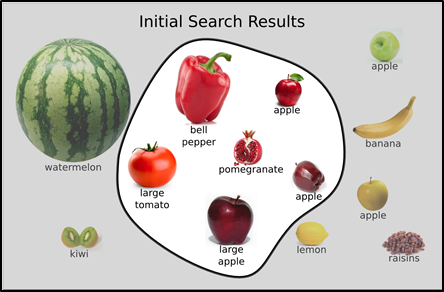
Image Copyright © Open Source Connections blog
What do see from this graphic? The immediate point is that the bell pepper is red, but it is a vegetable not a fruit. What I pointed out to the client however was there were no grapes in the results. A multi modal approach with human intervention could have avoided both these errors.
We’ll publish Part 4 – Justification for Using TAR and Conclusions – on Thursday.
So, what do you think? How would you define TAR? As always, please share any comments you might have or if you’d like to know more about a particular topic.
Image Copyright © Mars, Incorporated and its Affiliates.

Sponsor: This blog is sponsored by CloudNine, which is a data and legal discovery technology company with proven expertise in simplifying and automating the discovery of data for audits, investigations, and litigation. Used by legal and business customers worldwide including more than 50 of the top 250 Am Law firms and many of the world’s leading corporations, CloudNine’s eDiscovery automation software and services help customers gain insight and intelligence on electronic data.
Disclaimer: The views represented herein are exclusively the views of the author, and do not necessarily represent the views held by CloudNine. eDiscovery Daily is made available by CloudNine solely for educational purposes to provide general information about general eDiscovery principles and not to provide specific legal advice applicable to any particular circumstance. eDiscovery Daily should not be used as a substitute for competent legal advice from a lawyer you have retained and who has agreed to represent you.





